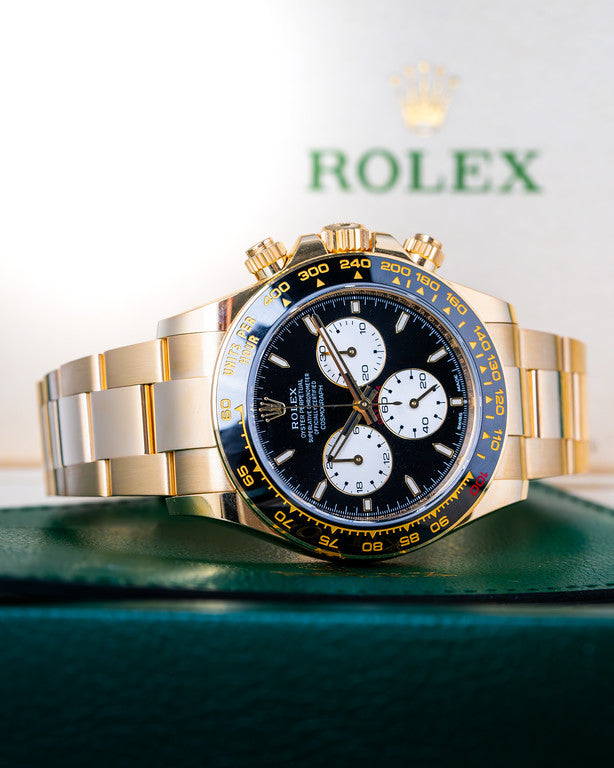If you’ve ever looked at a Submariner or GMT-Master, you’ve seen them—those distinctive three-pointed star hour hands that have become synonymous with Rolex sports watches. Watch enthusiasts call them “Mercedes hands” because of their striking resemblance to the Mercedes-Benz logo, but this nickname has sparked more theories and speculation than almost any other design element in the watch industry.
Despite being one of the most recognizable features on Rolex watches, the company has never officially explained why it chose this unique shape. That silence has led to countless theories ranging from symbolic tributes to pure coincidence. But when you dig into the technical details and timeline, the real reason becomes clear—and it’s far more practical than romantic.
What Are Rolex Mercedes Hands
The Mercedes hour hand refers to the distinctive hour hand design featuring a broad circular base divided by three radiating metal bars, creating a three-pointed star shape that mirrors the Mercedes symbol. This isn’t an official Rolex term—watch journalists coined the nickname due to the obvious visual similarity to the car brand’s logo.
These hands first appeared on the Rolex Explorer ref 6150 in 1953, marking a significant shift in the brand’s design philosophy. This was when Rolex was transitioning from luxury timepieces to professional tool watches designed for extreme environments. The Mercedes-shaped hour hand quickly became a defining characteristic of what we now recognize as Rolex’s sports watches.
Today, approximately 50% of Rolex models feature Mercedes hands, making them one of the most prevalent design elements across the brand’s current lineup. The design has remained virtually unchanged for over 70 years—a testament to both its visual appeal and functional effectiveness.
Which Rolex Models Feature Mercedes Hands
Mercedes hands are exclusively found on Rolex sport models, distinguishing them from dress watches that use traditional stick or baton hands. Here’s the complete lineup of current Rolex models featuring this iconic design:
Dive Watches:
-
Submariner and submariner date
-
Sea dweller
-
Deepsea
GMT and Travel Watches:
-
Gmt master ii
Explorer Series:
-
Explorer
-
Explorer ii
Yacht and Marine Models:
-
Yacht master
-
Yacht master ii
Aviation Models:
-
Air king
Mercedes hands appear on professional tool watches designed for specific activities like diving, aviation, exploration, and sailing. Dress models like the Datejust, Day-Date, and Cellini use more traditional watch hands that complement their formal aesthetic.
The Most Popular Theories Behind Mercedes Hands
Rolex’s official silence on the design’s origin has created a vacuum filled by various theories from watch enthusiasts and historians. While some sound plausible on the surface, most fall apart when examined against historical timelines and Rolex’s actual business practices. Let’s examine the four main theories that have gained traction over the decades.
The Land, Sea, and Air Theory
This popular theory suggests that the three points of the Mercedes star symbol represent Rolex’s mastery over different environments: land (Explorer), sea (Submariner), and air (gmt master). It’s an elegant narrative that appeals to the brand’s adventurous image and diverse professional watch lineup.
However, the timeline doesn’t support this theory. Mercedes hands appeared on the Explorer Ref 6150 in 1953, but the gmt master wasn’t launched until 1955. More importantly, early submariner models actually used pencil-style hands, not Mercedes hands. The submariner today uses Mercedes hands, but this came later as Rolex standardized the design across their sports line.
If rolex had planned this symbolic representation from the beginning, you’d expect all three watches to launch simultaneously with mercedes hands—which simply didn’t happen.
Mercedes Gleitze Tribute Theory
Some watch enthusiasts propose that Rolex named these hands after Mercedes Gleitze, the English swimmer who famously crossed the English Channel in 1927 wearing a Rolex Oyster. This feat became legendary for rolex, proving their waterproof claims and establishing their reputation for reliability in extreme conditions.
While Gleitze was certainly important to early Rolex marketing and even served as a brand ambassador, this theory has significant flaws. The visual connection is clearly to the Mercedes-Benz logo, not to Gleitze herself. Additionally, the hands appeared decades after her swim, making a direct tribute unlikely.
The confusion between Mercedes Gleitze and Mercedes-Benz is understandable, but the timing and visual evidence point away from this being the inspiration.
Hans Wilsdorf’s German Heritage Theory
Another theory suggests that Hans Wilsdorf, Rolex’s founder, designed the Mercedes hands as a subtle tribute to his German heritage. Proponents point to his birth in Germany and suggest the three-pointed design held personal significance.
This theory becomes problematic when you examine Wilsdorf’s actual life and the post-World War II timing of the hands’ introduction. While born in Germany, Wilsdorf spent most of his life in London and Geneva. During World War II, he was a strong supporter of the Allies and actively helped prisoners of war.
Given this background and the fact that Mercedes hands appeared in 1953—just eight years after the war ended—it’s highly unlikely that Wilsdorf would have chosen to honor Germany with this design element.
Evolution from Cathedral Hands Theory
The most historically supported theory traces Mercedes' hands back to cathedral hands, a popular design from the 1920s and 1930s. Cathedral hands featured a broad base with a pointed arch top, creating open spaces that were often filled with luminous material for better visibility.
These hands were commonly used on military watches and early sports timepieces because of their excellent readability. The design typically created three open spaces within the hand structure—similar to the Mercedes pattern but with a different overall shape.
Rolex likely adapted this functional concept, modernizing it into the sportier, more distinctive Mercedes design. This evolution makes sense given Rolex’s focus on improving professional watch functionality while creating a unique visual signature.
The Real Reason: Function Over Symbolism
When you strip away the romantic theories and focus on technical evidence, the real reason behind Mercedes hands becomes clear: they solve specific functional problems that plagued early luminous watch hands. Rolex chose this design for practical benefits, not symbolic meaning.
Improved Luminous Paint Stability
The metal frame with its three-pointed star pattern serves a crucial structural purpose for luminous material application. Early watch hands faced a persistent problem—luminous paint applied in large, continuous areas was prone to cracking, flaking, or falling out entirely, especially under the temperature extremes and physical shocks experienced by professional users.
By dividing the circular element into three sections with metal support bars, Rolex found the perfect balance between maximum luminescent paint coverage and structural integrity. Each section of luminous material is securely supported by the metal frame, preventing the large continuous areas that often failed in traditional designs.
This approach allowed Rolex to offer reliable, long-lasting luminosity—essential for dive watches, military watches, and other professional timepieces used in low light conditions. The design works so well that many Rolex models still use this same basic structure today, though the luminous material has evolved from radium to tritium to modern Super-LumiNova and Chromalight.
Legibility and Time Reading
Beyond durability, the Mercedes hand provides immediate functional benefits for time reading. The distinctive circular element with its three-pointed pattern makes the hour hand instantly recognizable, even when it overlaps with the minute hand. This common occurrence can cause confusion during quick time checks.
This clear visual distinction becomes especially valuable on four-handed watches like the GMT Master II and Explorer II, where additional hands could create visual clutter. The unique shape of the Mercedes hour hand ensures that users can quickly identify the hour reading even in low light settings where only the luminous elements are visible.
For dive watches and other professional timepieces, this split-second readability can be crucial. The design allows users to distinguish between hour and minute hands at a glance, reducing the chance of misreading time during critical activities.
Why Rolex Maintains Silence on the Origin
Rolex’s corporate culture explains why we may never get an official answer about Mercedes hands. The company, controlled by the Hans Wilsdorf Foundation, operates with extreme secrecy that extends far beyond typical business confidentiality. This isn’t just marketing—it’s deeply embedded in how the brand operates.
Employee non-disclosure agreements are famously strict, and Rolex maintains very limited public archives. Unlike many luxury brands that embrace their heritage through detailed histories and behind-the-scenes content, Rolex prefers to let its products speak for themselves.
This silence actually enhances the brand’s mystique. The mystery surrounding design elements like Mercedes hands creates rich lore that appeals to watch enthusiasts and collectors. It transforms functional design choices into symbols worth debating and researching, adding layers of meaning beyond the watches’ technical capabilities.
In many ways, the speculation and theories have become more valuable to the brand than any official explanation could be. The ongoing mystery keeps people talking about Rolex design elements decades after their introduction.
The Influence on Modern Watchmaking
The impact of Rolex Mercedes hands extends far beyond the brand itself. Approximately 60% of modern dive watches now use Mercedes-style hands or heavily inspired variations, making this one of the most copied design elements in the watch industry.
This widespread adoption isn’t just imitation—it’s recognition of the design’s proven functionality. Other brands have discovered the same benefits that rolex found in 1953: improved lume stability, enhanced legibility, and distinctive visual character that helps establish a professional tool watch aesthetic.
The influence spans from affordable sports watches to high-end dive timepieces from competing luxury brands. While some manufacturers put their own spin on the concept, the core principle of a reinforced, three-section luminous hour hand has become an industry standard for serious dive watches and sports watches.
This broad adoption has also created an interesting challenge for Rolex. As Mercedes-style hands become more common across the industry, the brand must continually innovate to maintain its distinctive edge while preserving the functional benefits that made the design successful in the first place.
Conclusion: The Enduring Legacy
The story of Rolex Mercedes hands perfectly captures what makes the brand special—the willingness to prioritize function over symbolism, even when the result becomes iconic. What started as a practical solution to luminous paint problems in 1953 has become one of the most recognizable design signatures in watchmaking. At G&G Timepieces, we specialize in authentic Rolex watches where you can experience the craftsmanship and attention to detail that make these designs legendary.





